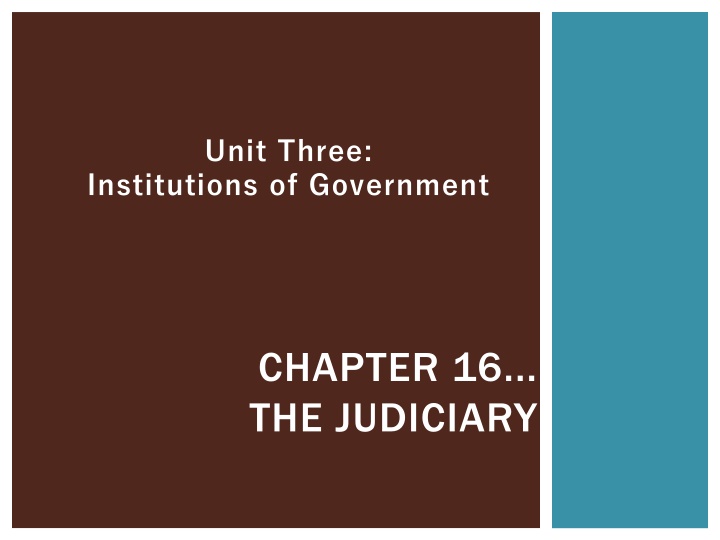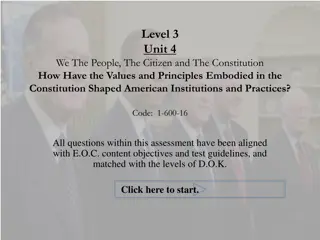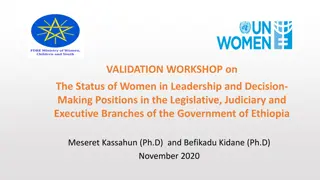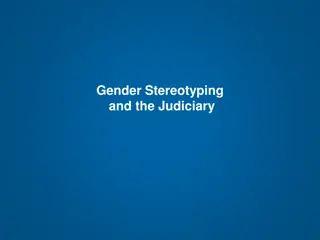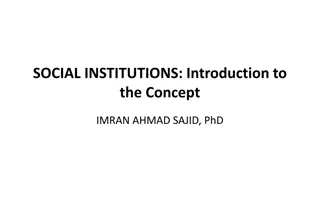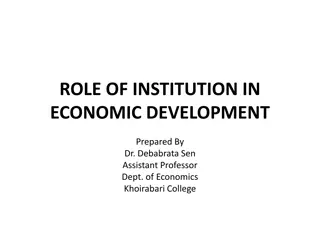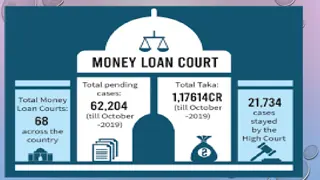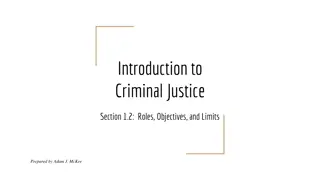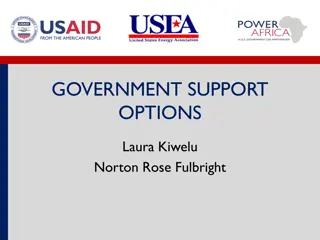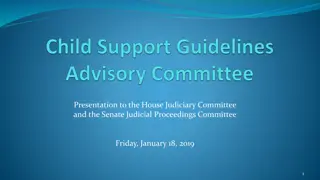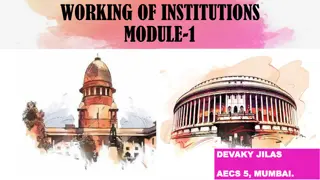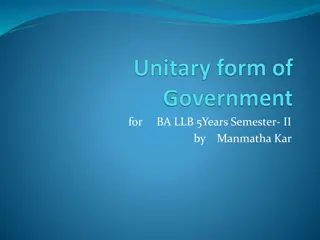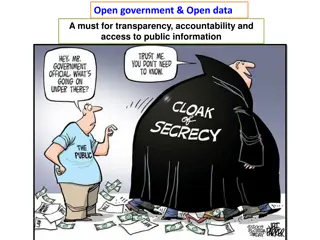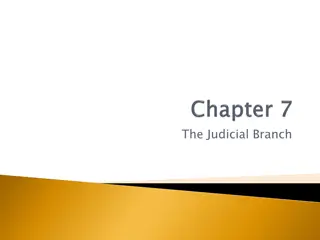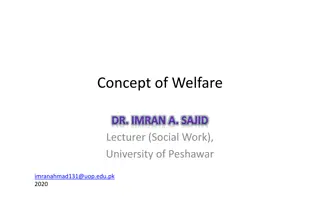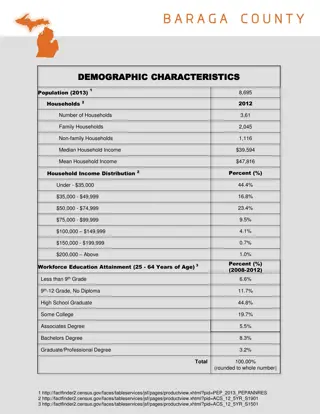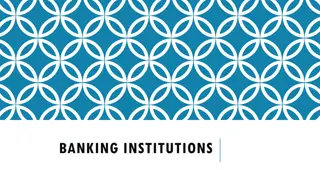Institutions of Government: The Judiciary in the USA
Strong judiciary in the USA exercises judicial review over laws and executive acts, applying existing law impartially. Historical eras highlight key cases and the evolution of federal courts. Discusses the judiciary’s role in nation-building, governance, and protection of rights post-Industrialization.
Uploaded on Feb 20, 2025 | 4 Views
Download Presentation

Please find below an Image/Link to download the presentation.
The content on the website is provided AS IS for your information and personal use only. It may not be sold, licensed, or shared on other websites without obtaining consent from the author.If you encounter any issues during the download, it is possible that the publisher has removed the file from their server.
You are allowed to download the files provided on this website for personal or commercial use, subject to the condition that they are used lawfully. All files are the property of their respective owners.
The content on the website is provided AS IS for your information and personal use only. It may not be sold, licensed, or shared on other websites without obtaining consent from the author.
E N D
Presentation Transcript
Unit Three: Institutions of Government CHAPTER 16... THE JUDICIARY
MAKING POLICY MAKING POLICY Very strong judiciary in the USA Very strong judiciary in the USA Judicial Review Judicial Review Declare void and unenforceable Declare void and unenforceable Laws of Congress Laws of Congress Acts of the Executive Branch Acts of the Executive Branch
MAKING POLICY https://encrypted-tbn2.gstatic.com/images?q=tbn:ANd9GcQK0zrD67dFKAdPRPDMAufJLHs_nc_6gB6RuFUSI71UtB8C1M1E Judicial Review Controversy Strict-constructionist view explicitly in the Constitution? Activist view what are the principles IMPLIED in the Constitution? Trends 70 years ago activists were Conservative Now activists more Liberal (current Supreme Court excluded)
DEVELOPMENT OF THE DEVELOPMENT OF THE FEDERAL COURTS FEDERAL COURTS They judged disputes between people with direct dealings between the two people Apply existing law What the LAW requires (states) Not what the judge BELIEVES the law requires
DEVELOPMENT OF THE DEVELOPMENT OF THE FEDERAL COURTS FEDERAL COURTS Historical Eras Historical Eras Nation building Issues Legitimacy of the Federal Government Marbury v. Madison McCulloch v. Maryland Slavery 1787 1787 1865 1865
DEVELOPMENT OF THE DEVELOPMENT OF THE FEDERAL COURTS FEDERAL COURTS Historical Eras Historical Eras Industrialization Industrialization Issues Issues Government and the economy Government and the economy Amendment XIV & businesses Amendment XIV & businesses Protect people from government meddling Protect people from government meddling of property without due process of property without due process Extended to businesses are people too Extended to businesses are people too Amendments XIV and XV Amendments XIV and XV Narrow interpretation Narrow interpretation Limited rights of African Americans Limited rights of African Americans 1865 1865 1937 1937
DEVELOPMENT OF THE DEVELOPMENT OF THE FEDERAL COURTS FEDERAL COURTS Historical Eras Historical Eras 1938 Social revolution Issues Personal liberties Social equality Packing the Court scheme (1937?) Political liberties Civil Rights States rights Very modern movement Allows states more power in regards to federal actions 1938 now now
DEVELOPMENT OF THE DEVELOPMENT OF THE FEDERAL COURTS FEDERAL COURTS The Structure of the Federal Courts The Structure of the Federal Courts Only the SCOTUS is mentioned in the Constitution
THE NATIONAL JUDICIARY STRUCTURE District Courts Most local level of federal courts 94 District Courts First time cases only NO APPEALS Hears the most cases of any level
THE NATIONAL JUDICIARY STRUCTURE Appellate Courts Courts of appeals And ONLY appeals 12 Circuit Courts PLUS Federal Circuit Court Nationwide reach Located in DC
THE NATIONAL JUDICIARY STRUCTURE The Supreme Court 9 Justices Takes appeals by selection Sometimes takes original cases
DEVELOPMENT OF THE DEVELOPMENT OF THE FEDERAL COURTS FEDERAL COURTS The Structure of the Federal Courts Congress created the other fed. courts Congress created the other fed. courts Constitutional Courts Constitutional Courts Has the same constitutionally granted powers Has the same constitutionally granted powers as the SCOTUS as the SCOTUS Protection of federal judges Protection of federal judges Can t be fired Can t be fired Can t have salary cut Can t have salary cut District Courts District Courts Courts of Appeals Courts of Appeals
DEVELOPMENT OF THE DEVELOPMENT OF THE FEDERAL COURTS FEDERAL COURTS The Structure of the Federal Courts The Structure of the Federal Courts Congress created the other fed. courts Legislative Courts Specialized purpose Judges Fixed terms of office Can be fired Can have salaries cut
DEVELOPMENT OF THE DEVELOPMENT OF THE FEDERAL COURTS FEDERAL COURTS Selecting Judges Ideology Important for determining behavior Other factors determining behavior Facts of the case Prior rulings by other judges A VERY strong argument presented by the lawyers
DEVELOPMENT OF THE DEVELOPMENT OF THE FEDERAL COURTS FEDERAL COURTS Selecting Judges Senatorial courtesy Senior senator of the state where the judge will be stationed PRIOR approval is needed
DEVELOPMENT OF THE DEVELOPMENT OF THE FEDERAL COURTS FEDERAL COURTS Selecting Judges Litmus Test One or two ideological issues which can be make or break issues Has allowed different interpretations in different circuits based on regional litmuses
DEVELOPMENT OF THE DEVELOPMENT OF THE FEDERAL COURTS FEDERAL COURTS Selecting Judges Litmus Test Grown into a MAJOR deal Will it even get out of committee? (Judiciary Committee) Will it die in a Senatorial filibuster? Great importance at SCOTUS No senatorial courtesy Share presidential philosophy
THE JURISDICTION OF THE FEDERAL THE JURISDICTION OF THE FEDERAL COURTS COURTS Dual Court System See Diagram in your packet
THE JURISDICTION OF THE FEDERAL THE JURISDICTION OF THE FEDERAL COURTS COURTS Federal Cases Most originate in district courts Most are simple law issues Not Constitutional issues Don t often lead to policy
THE JURISDICTION OF THE FEDERAL THE JURISDICTION OF THE FEDERAL COURTS COURTS Federal Cases SCOTUS Only hears cases it wants to hear Writ of certiorari Considers the petitions (writs) Four or more justices want to hear it, it goes before the Court
THE JURISDICTION OF THE FEDERAL THE JURISDICTION OF THE FEDERAL COURTS COURTS Federal Cases SCOTUS Often grants certiorari when Two or more circuit courts o appeals have decided in different ways The highest state court (Supreme Court of Pennsylvania) has ruled on a Constitutional issue State law in violation of the Constitution State law is in agreement with the Constitution
THE JURISDICTION OF THE FEDERAL THE JURISDICTION OF THE FEDERAL COURTS COURTS Federal Cases SCOTUS Only accepts about 100 per session (about 4%) Huge workload Law Clerks have a lot of power Deciding which cases should be heard Writing some of the justices opinions
GETTING TO COURT GETTING TO COURT EQUALITY EQUALITY Equality All parties are equal before the courts (legally equal) Economic equality? o High costs Pay for petitioning Pay for lawyers Pay for any previous hearings on the case o Time
GETTING TO COURT GETTING TO COURT (ECONOMIC) EQUALITY (ECONOMIC) EQUALITY Poor people can file In forma pauperis Free Criminal cases, lawyers are supplied to you
GETTING TO COURT GETTING TO COURT (ECONOMIC) EQUALITY (ECONOMIC) EQUALITY Interest Interest Groups may sponsor you Groups may sponsor you ACLU ACLU Liberal Liberal Free speech issues Free speech issues Center for Individual Rights Center for Individual Rights Conservative Conservative Racial quotas and Affirmative Action Racial quotas and Affirmative Action
GETTING TO GETTING TO COURT (ECONOMIC) EQUALITY (ECONOMIC) EQUALITY COURT Interest Groups may sponsor you Sometimes the interest groups leads the way Finding the plaintiff Mobilizing strategy Finding legal allies
GETTING TO GETTING TO COURT FEE SHIFTING FEE SHIFTING COURT Usually each party must pay his or her own fees Fee shifting permits plaintiff to collect court costs Can even collect money from government Code 1983 Sovereign immunity o Government can only be sued if it agrees it can be sued o Consent granted Contracts Negligence
GETTING TO COURT GETTING TO COURT STANDING STANDING Person may bring a case to court Criteria Actual controversy Must have been harmed just being a tax payer does not qualify must be harmed physically financially emotionally (very VERY tough to prove)
GETTING TO COURT GETTING TO COURT CLASS ACTION SUITS CLASS ACTION SUITS Case brought before the court By one person On behalf of the MANY who have been hurt in the same situation Civil rights Rights of prisoners Anti-trust lawsuits All members of the class MUST be notified
GETTING TO GETTING TO COURT SUMMATION SUMMATION COURT Summation To get the courts Must have Standing Resources
THE SUPREME COURT IN ACTION THE SUPREME COURT IN ACTION Most cases get to court by way of writ of certiorari Lawyers present BRIEFS Summarizes the facts of the case Summarizes the lower court s decision Gives arguments Cites legal precedents
THE SUPREME COURT IN ACTION THE SUPREME COURT IN ACTION Lawyers present Oral Arguments Strictly timed sessions Highlight the brief Answer questions posed by judges
THE SUPREME COURT IN ACTION THE SUPREME COURT IN ACTION The Keys Other key players Solicitor General Nation s top trial lawyer Often in front of Supreme Court Friends of the Court AMICUS CURIAE Interested parties not directly involved A form of judicial lobbying Legal Periodicals read by Justices The Keys The Keys
THE SUPREME COURT IN ACTION THE SUPREME COURT IN ACTION Conference room debate Strictly private Discuss the case Majority wins Tie goes to the lower court s ruling
THE SUPREME COURT IN ACTION THE SUPREME COURT IN ACTION Writing an opinion Per curiam opinion Explains the majority decision Brief Unsigned
THE SUPREME COURT IN ACTION THE SUPREME COURT IN ACTION Detailed opinions Opinion of the Court (Majority Opinion) Opinion of the Court (Majority Opinion) Longer Signed by those in the majority Concurring Opinion Concurring Opinion Agrees with the majority But for different reasons Dissenting opinion Dissenting opinion The losing opinion
THE SUPREME COURT IN ACTION THE SUPREME COURT IN ACTION Judges will often vote for a position They oppose ideologically They support the wording of the law
THE POWER OF THE FEDERAL COURTS THE POWER OF THE FEDERAL COURTS The power to make policy Interpretation of the Constitution Measures of the power Laws have been declared unconstitutional
THE POWER OF THE FEDERAL COURTS THE POWER OF THE FEDERAL COURTS The power to make policy Court often changes its mind Stare decisis Precedent set Importance Makes laws valid over time (stability) Equal justice means laws need to be decided pretty much the same
THE POWER OF THE FEDERAL COURTS THE POWER OF THE FEDERAL COURTS Measures of the power Court often changes its mind Reasons to change Times change The previous or lower courts could have been wrong
THE POWER OF THE FEDERAL COURTS THE POWER OF THE FEDERAL COURTS Measures of the power Courts are willing to handle matters once handled by the legislatures Political Questions Questions which the Constitution implies a different branch should deal with Lessened in modern times
THE POWER OF THE FEDERAL COURTS THE POWER OF THE FEDERAL COURTS Measures of the power Remedies Actions which must happen to correct a situation Basis for declaring a remedy Constitutional interpretation Interpretation of federal laws
THE POWER OF THE FEDERAL COURTS THE POWER OF THE FEDERAL COURTS Judicial Activism Controversial Supporters Courts serve the purpose of correcting the actions of the other branches The peoples last resort Critics Judges don t have the expertise Judges don t have the long term effects in mind Judges are not elected
THE POWER OF THE FEDERAL COURTS THE POWER OF THE FEDERAL COURTS Judicial Activism Growth Government has grown larger Easier for people to get Standing Easier to pay costs Judges now accept activism as part of their role
THE POWER OF THE FEDERAL COURTS THE POWER OF THE FEDERAL COURTS Legislation and the Courts Congress passes vaguely worded laws Allows more judicial interpretation Some laws are bound to be contested by one side or the other before the courts
CHECKS ON JUDICIAL POWER CHECKS ON JUDICIAL POWER Judicial Restraint encourages judges to limit the exercise of their own power asserts that judges should hesitate to strike down laws unless they are obviously unconstitutional though what counts as obviously unconstitutional is itself a matter of some debate.
CHECKS ON JUDICIAL POWER CHECKS ON JUDICIAL POWER Judicial Restraint vs. Activism
CHECKS ON JUDICIAL POWER CHECKS ON JUDICIAL POWER No army No way to ENFORCE a decision
CHECKS ON JUDICIAL POWER CHECKS ON JUDICIAL POWER Congress Can alter composition of courts Appointments Takes a long time Does create change in direction of the Court Impeachments Not a big impact Ideology not usually an acceptable rationale
